#PREMIERE ON IQIYI (AUGUST 19TH)
Explore tagged Tumblr posts
Text





LOVE IN TRANSLATION (2023, THAILAND)
Trailer Teaser Highlights
Premiere Friday August 19, 2023 on IQIYI
MDL Synopsis: One wants to run a successful business, another wants to pursue a Chinese girl. Unexpectedly their desperate pursuits bring them closer together.
Though the language is not understood when communicating with the heart, the message is received.
Starring: PITTAYA SAECHUA aka DAOU as YANG

KANTAPON JINDATAWEEPHOL aka OFFROAD
as Phumjai

Directed By: PHADUNG SAMAJARN aka LIT
@pose4photoml @lutawolf
#POST: TRAILER/TEASER HIGHLIGHTS#THAI BL SERIES#PREMIERE ON IQIYI (AUGUST 19TH)#NONE OF THESE GUYS LOOK LIKE OFFROAD#OFFROAD WAS SAINT ON OUR DAYS#LOOKS INTERESTING#My GIFS#MYGIFSET#MY-GIF-EDIT#EITHER OFFROAD CHANGED HIS LOOK OR HE'S NOT IN THIS#MAIN LEADS ACCORDING TO MDL
23 notes
·
View notes
Note
Hello, if you are free. I would love to hear your thoughts and analysis on the costumes of "Story of Yanxi Palace" (2018) and the sequel "Yanxi Palace: Princess Adventures" (2019)
Hiya! I'm probably not the most qualified person to talk about Manchu fashion or court dress but I'll try my best😭
Story of Yanxi Palace (2018) 延禧攻略
Story of Yanxi Palace (Chinese: 延禧攻略) is a Chinese period drama series recounting the struggles of a palace maid in the court of the Qianlong Emperor. It was created by Yu Zheng, with original screenplay written by Zhou Mo, and later developed into a novel by Xiao Lian Mao. Starring Wu Jinyan, Charmaine Sheh, Qin Lan, Nie Yuan, Tan Zhuo and Xu Kai, the series premiered on iQiyi from July 19, 2018 to August 26, 2018. During its run it was streamed more than 15 billion times. (copy and pasted from Wikipedia) For the costuming it should be noted that the timeline of the show starts in 1741, the early Qianlong era. The story takes place in court, meaning that most characters are Manchu and wear Manchu fashion and court dress.
A bit of context for those unfamiliar with the Qing: the royal family (and the aristocracy in general) in the Qing were ethnically Manchu, whereas the majority ethnicity in China both back then and nowadays is Han Chinese. Han and Manchu men shared the same fashion system while the clothing of Han and Manchu women remained distinct; I’m more knowledgeable about Han women’s fashion so I can’t guarantee that everything I say about Manchu womenswear is legit... In the Qing court, clothing worn to formal occasions followed official regulations, meaning they were different to casual fashion----this is, I think, very important to distinguish.
All the screenshots are from the Youtube uploads.

Source here
So, um, just from the posters and promotional photos alone I could tell that some of the costumes are not from the 18th century... The overall vibe of the costumes in this show resemble the mid 19th century, particularly the mid 19th century because there are quite a couple images and extant garments from this era.
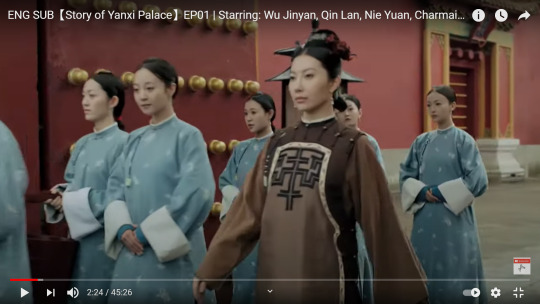
Two minutes in and I have a lot of questions. Why are the ladies wearing gowns with this loose, white 挽袖 wanxiu (folded cuff) design? The relaxed sleeve width is from the 19th century, in the 18th century when folded cuffs were worn they were usually more form fitting. In the mid 18th century, formal Manchu women’s gowns like 吉服 or 常服 had slender sleeves with 马蹄袖 matixiu or “horse hoof” cuffs, whereas informal gowns had either horse hoof cuffs or straight sleeves that were also very tight fitting. Also the super low collar is very late 19th century Han women’s robe, again incorrect for both time and ethnicity. Manchu clothing was originally collarless but in the 18th century some Manchu ladies added collars to their robes or wore fake ones; these would look similar to those on Han women’s clothing at the time, soft (unstiffened), tall and closed with two buttons. The lady in brown is wearing a 巴图鲁坎肩 batulu “warrior” vest, a vest that could be opened from the front and sides, that screams 19th century as well. Her hair with the 燕尾 yanwei or “swallow tail” bun at the back is incorrect; swallow tails were worn by Han women in the late Ming and some eras in the Qing and were not coopted by Manchu women until the friggin turn of the 20th century. I genuinely do not understand the need to give every Manchu lady a swallow tail in these period dramas, it’s wrong for the era and ethnicity and generally makes no sense.

Source here
Portrait of Empress Xiaoshen from the Daoguang era (1821-50) wearing a 衬衣 chenyi robe similar to that in the screenshot with a kerchief.

Source here
乔园之三好图 from the 1670s or 80s showing Han women in swallow tail hairstyles.
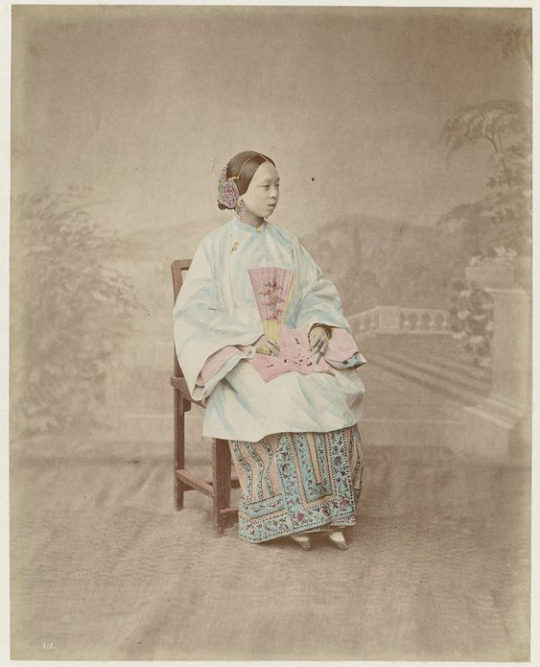
Source here
1870s or 80s photograph of a Han woman wearing a robe with the super low collar.

...ladies, gentlemen and non binary fellows, we have arrived in the mid 19th century. Everything, from the 两把头 liangbatou hairstyle that looks like a landline telephone, the red strings tying the hair together, the flowers in the hair to the cut and decoration of the chenyi and low collar with binding, literally everything except the swallow tail is directly lifted from the mid 19th century. Qianlong is spinning in his grave so fast he can power the Forbidden City. The costumer even gave them incorporated 云肩 yunjian or cloud collar designs, which were more of a Han thing, to further spite him.
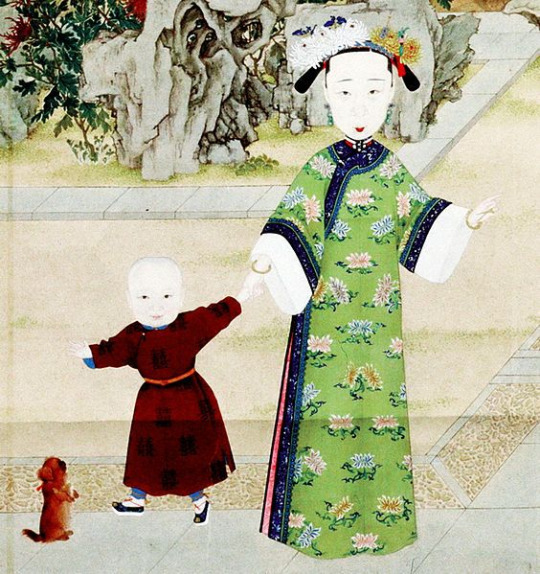
Source here
Portrait of Empress Xiaojingcheng from the Daoguang era (1821-50).

Source here
Mid 19th century Han women’s robe with an incorporated cloud collar design.

Source here
Mid 18th century painting showing Manchu women. This is probably later than the 1740s and less realistic because it’s a Cantonese painter’s understanding of Manchu fashion but the women in Yanxi Palace should still look more like this than whatever was going on in the 1850s. You can see their sleeves are tighter and more form fitting. The 钿子 dianzi (more on that later) they’re wearing is commonly believed to have evolved from braided hair covered with a turban. In the 17th century and before, Manchu women used to wear braided hair in a bun, and that was likely the precursor for this hairstyle which was in turn the precursor to dianzi and liangbatou.

Source here
You can see the hair bun covered by cloth better in this painting, 春闺倦读图轴 by 冷枚 Leng Mei depicting a fashionable Manchu lady. The painting is from 1724 so maybe not exactly appropriate for Yanxi Palace, but you can clearly see similarities and continuity with the previous painting. You can also see that she’s wearing another garment underneath to which the standing collar is attached.
I do really appreciate how they arranged the flowers on the liangbatou in an asymmetrical way and how the flowers are relatively small and delicate. Asymmetry was the soul of the liangbatou hairstyle in the 1850s. In older dramas, Manchu women would usually wear a giant 旗头座 qitouzuo (artificial hair base) with an equally giant flower right in the middle, and a bunch of tassels and small decorations everywhere. That style did not become a thing until the turn of the 20th century, even then it wasn’t that insane.
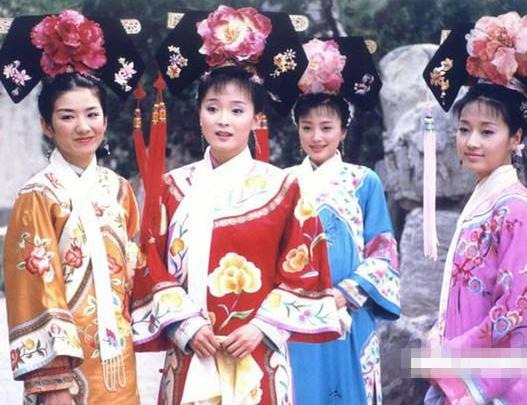
Source here
Older dramas be like. I swear this look needs to be on the Qing Dynasty costuming board of shame; it was so wildly incorrect but so popular and led so many people down the wrong way...

Source here
Old photograph of a Manchu couple from 1917. The flower is nowhere as big and there are no excessive decorations. This looks kind of like a special occasion photograph though? Normally Manchu women wouldn’t even wear giant flowers on the liangbatou (alternatively 大拉翅 dalachi or 旗头 qitou).

Source here
Another photograph from the 1900s/1910s showing liangbatou without the giant flower.

This is kind of interesting. The coat is probably a 吉服褂 jifugua (jifu coat), a black-ish blue coat with 八团 batuan or eight roundels design worn over a jifu robe. Jifu was a ceremonial ensemble that saw a lot of daily use in the Qing court, so I guess this occasion was appropriate. She has the horse hoof cuff on the robe underneath which is legit. She’s wearing a 领约/项圈 lingyue/xiangquan necklace which did exist though I’m not sure if it would’ve been worn with jifu. The headpiece is maybe going for a 钿子 dianzi impression, though I haven’t seen any dianzi which is completely gold. Dianzi was not the sole headwear for jifu though, in the Qianlong era jifu was still commonly worn with 吉服冠 jifuguan (jifu headpiece, the red hat with a jewel on top). Either that or it was supposed to be a 凤冠/翟冠 fengguan/diguan worn by Han women. As to the fake standing collar, ummm it was doable but not necessary or common in the 18th century. Manchu women’s clothing was originally collarless and did not become unanimously with collar until the 19th century. Jifu was also commonly worn with a fur trimmed collar, not the “Peter Pan” style as shown here. The frequency at which standing collars appear in this show is a bit sus.

Source here
Closeup of 崇庆皇后万寿图 from 1751 showing court women in jifu coats.
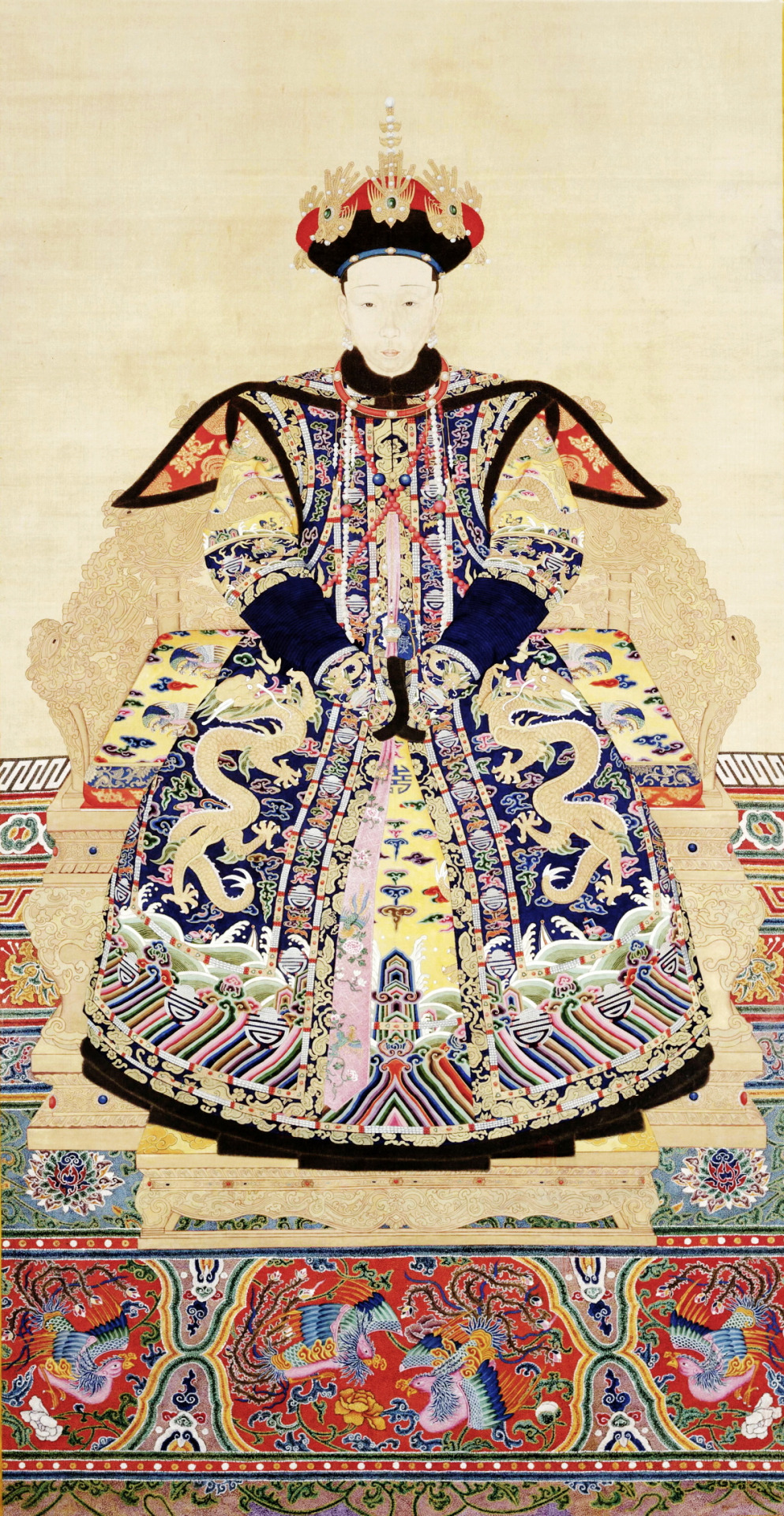
Source here
Portrait of Empress Xiaochunyi in a 礼服 lifu, the most formal ensemble, wearing a lingyue (the solid circular necklace). Lingyue is more commonly seen in portraits with lifu and not jifu.

Source here
Qianlong era (?) painting showing Manchu ladies wearing informal robes with fake collars, dianzi and lingyue. Not jifu.

This headpiece is probably supposed to be a dianzi this time. The shape and size look legit. The individual decoration pieces could be added according to personal preference, so there isn’t much that could go wrong. Extra cookie for the 一耳三钳 yi’ersanqian or row of three earrings, that was a very distinctly Manchu accessory. I'm not sure whether it’s appropriate to have the emperor (I assume it’s Hongli here) in a 礼服 lifu, this ultra ceremonial outfit, for an occasion like picking court ladies.

Source here
Extant dianzi. Dianzi are usually made of fabric braids and metallic threads that form a solid base for decorative pins, very much like the diji I mentioned in my Song of Youth review.

The inside of the lady on the left’s outfit revealed by the slit in the jifu coat is pretty great. It looks like a standard jifu robe with eight roundels and 海水江崖 haishuijiangya or waves and cliffs motifs.

Source here
Similar extant jifu robe from the Qianlong era.

This lady is not Han for all I know but wears an actual cloud collar, which fell out of favor in the early 18th century as casual fashion and became a garment in formal wear. Manchu women did sometimes borrow items from Han fashion and wore cloud collars but it wasn’t so common at all.
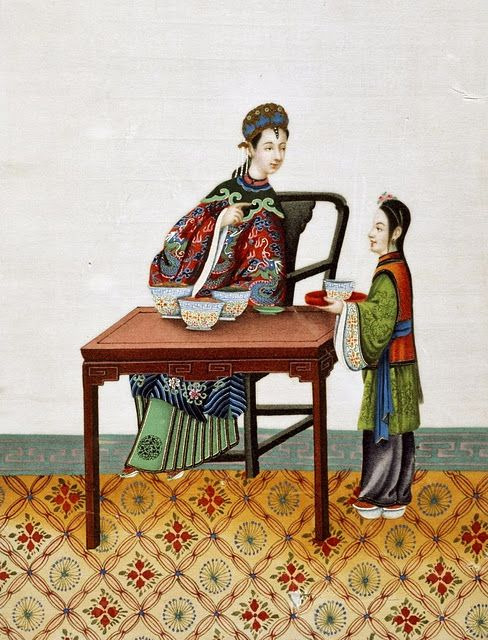
Source here
Daoguang era (1821-50) export painting showing Han woman in formal attire wearing a separate cloud collar.

Source here
Mid 19th century Manchu lady wearing a cloud collar.
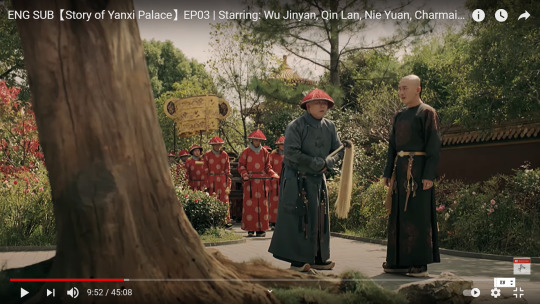
YES! The emperor is finally allowed to wear something other than the friggin yellow lifu!! The guy on the right is supposed to be Qianlong and he’s in a collarless informal robe which! has! four! slits!!! Great period detail omg. The standard men’s robe would have four slits (sides, front and back) when worn by the emperor. I would prefer if it had horse hoof cuffs though.
I skimmed the next couple episodes and it seems like there’s not much else to say about this show, the costumes pretty much stay the same (they never got out of the 1850s). This show really got me wondering something though. You know how in recent years everybody loves Qianlong era fashion so much to the point that costumers insert bits and pieces of Qianlong era Han fashion into shows set in the Ming Dynasty? Well, for Yanxi Palace they finally get to actually do the Qianlong era and they suddenly... don’t. They suddenly want to sashay off into the 19th century now. I...
However, despite the incorrect time period and all the minor questionable things, I am beyond thankful for this drama since it kind of started the trend for more historically accurate dramas (Imperial Doctress 女医明妃传 from 2016 was the inciting incident and this and Ruyi’s Royal Love in the Palace 如懿传 was the point of no return). I also cannot be grateful enough for the first ever Qing court drama that dared to explore Qing fashion beyond the 1910s and did not use stereotypical Manchu women’s outfits you can rent from any costume shop for less than 10 euros. This show is going down in Chinese period costuming history I’m calling it now. Well it’s already iconic. Overall I’d give the costuming a 4/10 for the batshit crazy time travelling, though if it were set in the mid 19th century I’d honestly give it 8/10.
Once again just to give you an idea of how shite Qing court drama costuming used to look, I will show you some images that give me psychic damage.
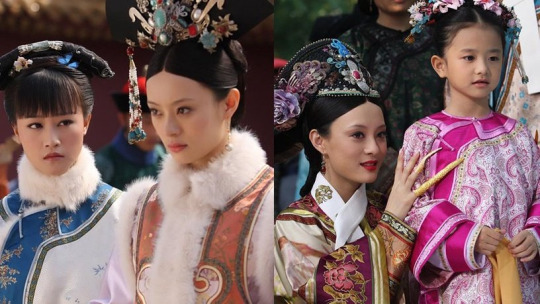

Source here

Source here
Empresses in the Palace 甄嬛传 (2011). Wtf is going on? Not even brothels in belle époque Beijing turned looks like these. Growing up as a child watching these dramas I always felt really sorry for the emperor cause he’s the emperor of China but could only wear one or two outfits. As a preteen in the early 2010s who shopped exclusively at Forever 21 I had a more interesting wardrobe than he did. God I love tearing the costuming in childhood dramas to shreds. If y’all want me to go feral on any old dramas my askbox is always open :)))) Actually no, because there isn’t much to say besides that they’re all shite.

Source here
Palace 宫 (2011).
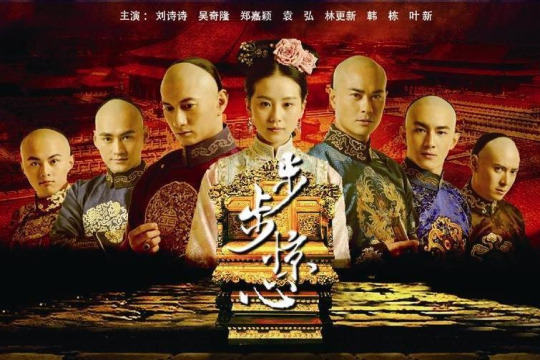
Source here
Scarlet Heart 步步惊心 (2011). Did something go down in 2011? Why is it out to get me?
Anyway here are some articles about Yanxi Palace that explain everything better than I did, thought they’re all in Chinese: x, x
The sequel hasn’t aired yet to my knowledge and the costumes don’t look that great so I won’t talk about it here. Maybe when it airs we can make fun of it together :3
#costume analysis#story of yanxi palace#chinese fashion#historic fashion#19th century#qing dynasty#Manchu clothing
331 notes
·
View notes